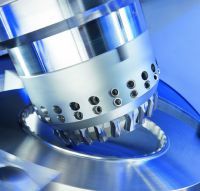IMTS Preview: Klingelnberg
Klingelnberg presents its latest skiving innovations at IMTS 2012. This tool system can be used on bevel gear milling machines and allows for a productive, stable and precise production process, particularly for internal gears. Despite high productivity and system-inherent accuracy, the breakthrough of skiving has been denied due to the tool problem. The chip formation process in skiving is very complex whereby large negative rake angles and only very small clearance angles arise during the process. The current tools, mostly cylindrical or conical solid carbide cutting wheels, have no degree of freedom for the necessary optimization. In addition to high machining forces, negative cutting angles also consistently lead to excessive wear of the tools meaning that the tool costs per component largely surpass the proportional machine costs.
Klingelnberg's newly developed software shows the exact chipping conditions and therefore allows for a targeted optimization of the cutting geometry and the production movement. The new stick blade tool system uses carbide technology which has long been used for bevel gears. "Skiving itself is in fact an ancient concept. The key innovation hereby lies in the use of stick blades and the resulting design possibilities for the cutting edge - a breakthrough in cutting technology," says Dr. Hartmuth Müller, CTO of Klingelnberg.
The stick blade has the distinct advantage of offering optimal cutting geometry through grinding. This is a necessary condition for the optimization of the chip formation process and therefore forms the basis for the breakthrough of skiving. The entire process is highly energy-efficient, productive and flexible. In addition to the free design of the tool, tooth flank modifications can also be applied by superimposing additional movements during the skiving process. These advantages in comparison to gear hobbing, gear shaping or broaching are of particular importance for the production of internal gears. A simple comparison of shaping and skiving productivity shows that skiving is up to ten times quicker and offers a significantly longer tool life.
Although skiving is a machining process using a defined cutting edge, the surface qualities achieved are outstanding. Due to the very high frequency with which the cutting edges move across the tooth flanks to be produced, a completely different surface texture is achieved than, for example, that of gear hobbing or shaping. In the image, the movements of two successive cutters in the tooth space are displayed as blue tracks. The distance of these tracks is determined by the axial feed rate with which the tool is moved along the face width of the gear to be produced. The cutting frequency is up to ten times higher than that of gear hobbing. As a result, a finer surface texture is achieved without the hollows created by gear hobbing or the grooves created by shaping and caused by tool wear. The incorporation of all steps along the process chain to form a continuous data network, guarantees stable and secure manufacturing processes. For Klingelnberg this is a trusted and globally approved approach within the scope of the closed loop concept. In order that the user is able to benefit from the same process security for skiving as that for bevel gearing, Klingelnberg has developed the closed loop for skiving which also incorporates tool preparation operations.
Skiving can be executed on the Oerlikon C29 and C50 bevel gear milling machines. These machines ensure a highly-precise coupling of all movements which are necessary for skiving. The highly dynamic process also requires a rigid machine design. The vertical arrangement of the tool and work piece spindle offers particularly favorable conditions for chip removal. The C29 and C50 machine series meets all conditions required for skiving.





